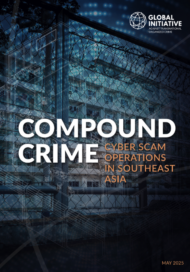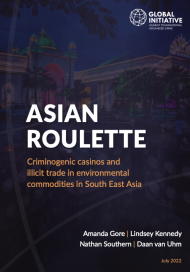Posted on 12 Jun 2025
The growth of cyber scam centres around the world is fuelling a global human trafficking crisis on a scale and organizational complexity rarely seen since the height of the transatlantic slave trade. In just a few years, hundreds of thousands of people have been transported into scam operations, many of them forced to perpetrate fraud under threat and in abusive conditions. Often hailing from countries with high unemployment rates or a surplus of tech-savvy graduates, those duped with promises of legitimate jobs may not match stereotypical images of a trafficking victim, leading both them, and those they come into contact with along their journey, to miss important red flags.
But vulnerable people in unfamiliar settings, lacking support or access to their passports, are easier to manipulate, intimidate and control. Once they are inside the scam compounds where these operations are conducted, getting them out is difficult. Stopping victims from reaching compounds could be a far more effective way to prevent harm and it also disrupts the labour supply.
A report by the International Organization for Migration found that in 2021, globally, four out of five trafficking victims travelled through official border crossings, such as airports. Airlines and airports are thus ideally placed to identify those at risk and hold a wealth of data that could provide vital intelligence in preventing cyber scams.
Identifying those at risk
Over the past decade, airlines have introduced a series of measures related to human trafficking. The UK’s 2015 Modern Slavery Act requires large organizations to report annually on steps being taken to make their operations and supply chain free of human trafficking, which the International Air Transport Association (IATA) estimated affected over 80 airlines. In 2016, the US Congress mandated that US airlines provide awareness training to cabin crew, while in 2018, IATA, which represents 340 airlines and 80 per cent of air traffic, committed to a number of anti-trafficking initiatives. IATA updated this guidance in 2023, highlighting the importance of timely reporting and training customer-facing employees to detect and report human trafficking.
Also in 2023, the International Civil Aviation Organization released a manual for combating human trafficking, encouraging its 193 member states to implement a ‘zero-tolerance policy’ to trafficking at their airports. Recommendations included staff training, reporting protocols, public awareness-raising, data sharing and better coordination between airports, airlines, NGOs and government agencies.
However, these recommendations are not reflected in practice. In interviews, customer service agents working for a major airline at a London airport that serves high-risk trafficking locations said that they did not recall receiving any relevant training nor know when or how to flag a suspected victim. This contradicts repeated claims by the airline and its parent company that trafficking awareness training has been rolled out to all staff since 2017.
At Phnom Penh airport, conversations with airport security staff revealed that they had not received training and did not know procedures for identifying or reporting possible trafficking victims or recruits for scam compounds. In an interview, representatives of the airport’s operator, the VINCI group, explained that they have an internal reporting system and training is mandatory, but responsibility for delivering this falls to individual airport management and there is no centralized way to ensure compliance.
Indeed, on multiple occasions between 2023 and 2025, the authors witnessed non-uniformed people with company-name signs waiting airside, an area that is normally accessible only to airport staff and passengers. These ‘handlers’ appeared to be meeting large numbers of Chinese and Vietnamese solo travellers who seemed unused to flying, nervous about speaking to anyone around them and carried very little luggage – all red flags for trafficking.
Despite being around the same demographic, these arrivals did not know each other, suggesting they may have responded to scam company recruitment ads, which typically specify an age range and gender. The travellers gave their passports to the ‘handlers’, who managed the visa and security procedures and then took them to buses waiting outside. Such behaviour suggests that travellers were possibly destined to work in scam compounds. Indeed, plane tickets the authors found discarded during this period in a temporarily vacant scam compound notorious for trafficking indicated that at least some of the victims held there had flown the same route and airline as one group encountered at the airport.
According to experts consulted, non-airport staff could not meet travellers airside without the complicity of immigration officials and airport management. When asked if they were concerned about these travellers being possibly trafficked, ground staff became aggressive. The VINCI group said they were unaware this was taking place and confirmed they did not know of a legitimate reason why these individuals would be permitted airside, but said the company has a rigorous anti-bribery policy and full-coverage airport CCTV in place and would need to investigate further.
As a French conglomerate with over 5 000 employees, VINCI is required under the French Duty of Vigilance Law to publish plans for identifying risk and preventing violations of human rights and fundamental freedoms. While its 2024 Duty of Vigilance Plan does not cover identifying or preventing human trafficking, the company has rolled out comprehensive counter-trafficking policies in airports in the UK and the Dominican Republic, developing guidance in collaboration with international organizations.
Sarah Tesei, head of Corporate Social Responsibility, said VINCI has a ‘strong, dedicated team’ dealing with human rights issues, but stressed that initiatives require collaboration with a local partner, as well as the respective country’s government or law enforcement, who have ultimate jurisdiction over what takes place inside an airport. This is a major challenge for airports operating in high-risk locations that also rank poorly for corruption, including Cambodia (a notorious destination for people trafficked into scam compounds) and Latin American countries targeted by scam industry recruiters.
Airports and airlines often outsource to private consultancies or civil society organizations the task of working out how to eliminate human trafficking from their supply chains, for instance the HRC and Slave-Free Alliance, a consultancy launched by the NGO Hope for Justice. However, interviews with HRC’s Sharlene Chen and Susan Banister from Slave-Free Alliance highlighted that, without industry-wide standards in place, this leads to inconsistencies in operating and interviewing procedures. Another problem is that airline and airport staff are not law enforcement and so cannot detain people for questioning or stop passengers from boarding if they meet the end country’s entry requirements. In addition, they must be careful that whatever they put in place will not make things worse for the person being trafficked.
As a result, the responsibility for intercepting suspected trafficking victims generally falls to border police or immigration authorities, but collusion with traffickers and scam syndicates is rampant. For example, in 2021, in the Philippines, 45 Bureau of Immigration employees were dismissed for taking bribes to allow foreign nationals to bypass formal immigration procedures. In Myanmar, the United States Institute of Peace found that senior leaders in the Karen Border Guard Force partnered with Chinese criminal groups to operate scam compounds, while in 2018 a former Croatian police officer was convicted of helping run a transnational criminal group that trafficked Taiwanese nationals to scam compounds in Slovenia and Croatia. In Cambodia, two victims held at a (now-sanctioned) compound on the Thailand border alleged that their captors paid local police US$30 000 in protection money every month.
A wealth of data
However, even in situations where airports and airlines might be wary of collaborating with authorities and where corruption is reportedly widespread, they are still invaluable sources of data. Identifying who purchased trafficking victims’ tickets, for instance, could be crucial evidence for cross-border police investigations. Investigators looking at changes in the scam industry could use aggregated data on unusual patterns, such as high rates of unused baggage allowance (consistent with HRC’s findings that trafficking victims often travel with very little luggage or money), increased demand between risky locations or a preference for complicated routes unexplained by pricing dynamics (often used to mask the country of origin when this has been flagged as high risk). Also, a surge in foreign nationals travelling from a country that is cracking down on cyber scams (for example, the Philippines) to another scam hub (such as Georgia) may be a sign that scam syndicates are relocating and workers re-trafficked.
Research data and interviews with victims can also assist airports and airlines to understand scam industry trends. For instance, our research found that victims are often told that the jobs are in one country but are then transported to scam compounds in another. Analysis of Telegram job advertisements shows that, while most people trapped in scam compounds are from East and South East Asian countries, increasing numbers are trafficked from East Africa, or were foreign nationals living in the United Arab Emirates with valid work permits. Cyber scam companies recruit workers who speak the language of their targets, and typically source models or actors from Central Asia to pose as love interests on video calls.
Data sharing works both ways – by being alerted of these trends, airlines and airports can better flag suspicious behaviour, anticipate emerging risks, and collaborate with agencies and organizations they trust to intervene.



